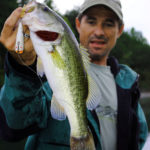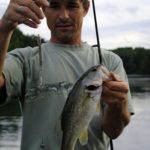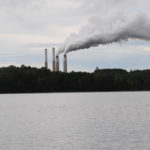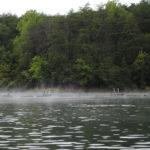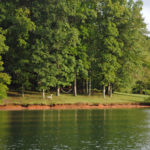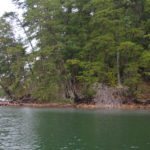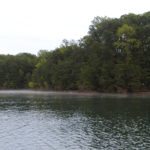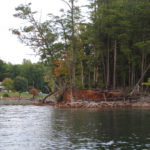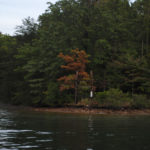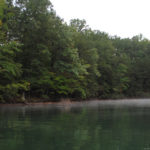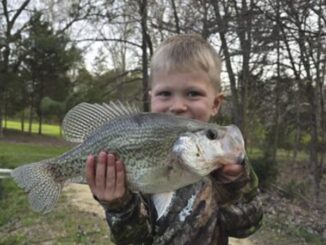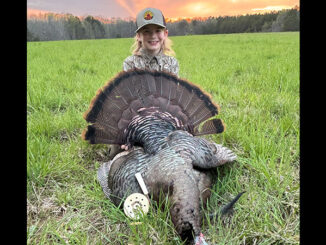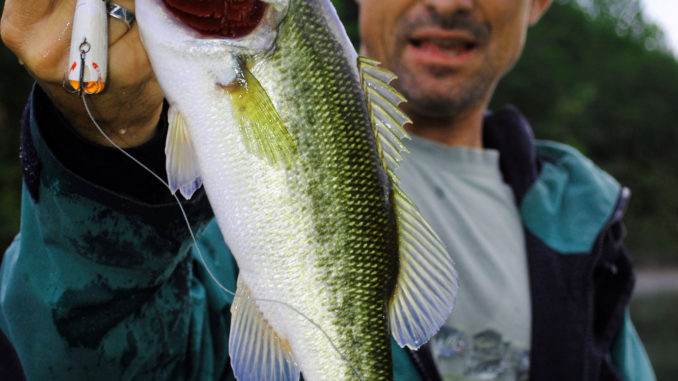
This bass fishery is overlooked, underfished and improving every year. Take a tour of its best fall spots.
At 3,863 surface acres, Belews Lake isn’t large enough to be considered one of North Carolina’s major reservoirs, but it’s by no means just a little pond out in the country north of Winston-Salem near the “four corners” junction of Stokes, Forsyth, Guilford and Rockingham counties.
Still, it doesn’t get a lot of attention from fishermen outside its local area; you rarely see bass clubs from, say, Raleigh or Hickory visiting for tournaments.
It could be that fishermen haven’t really been talking much about the lake because it wasn’t too long ago that the Duke Energy reservoir, home of the largest coal-fired station on the power company’s grid, didn’t have any fish — at least no normal ones.
Impounded in 1973, fishermen experienced the kind of success at Belews Lake they usually do at new reservoirs – they caught the daylights out of them.
Then, suddenly, the fish disappeared. It took until 1978 before scientists figured out that a massive fish kill of nearly all species had taken place because a poison — selenium — had leaked into the lake as a wastewater by-product of the power plant’s cooling system.
Once the company got the problem under control, the fishery started to work its way back toward normal. It could be that, 25 years after the problem was taken care of, the lake is going through the phase that was interrupted.
The only problem is, not too many fishermen know about Belews, and according to guide Joel Richardson of Kernersville, they’re missing plenty.
“The fishery is getting good, getting great,” said Richardson, a former pro bass fisherman who cut his fishing teeth at Belews when conditions were suboptimal, at best. “I think the water has gotten to the point where it’s cleaned up and the bass have repopulated.
“There’s a great supply of small baitfish that supplies the bass’ needs. It’s a fabulous fishery year-round, but I think fishermen have gotten intimidated by the clear water. Eighty percent of the people who fish don’t fish deep enough. To me, you fish it the same way you fish Norman or Badin.”
So Richardson spends a lot of time with deepwater finesse baits like drop-shot and shaky head rigs in his hands, but he’s always got topwater baits and floating worms tied on.
The kicker with Belews is that, since it’s got a hot-water discharge from the power plant, the water in about two-thirds of the lake is warm all the time, often in the 70s through the winter. That makes for a lot of active bass at times when they would be dormant in other bodies of water, and it protects the threadfin shad that “feed” the fishery from any cold-stun winter kills.
Belews also fishes “opposite” of what many fishermen would expect. When the sun’s out the brightest, Richardson said, the bass are liable to be in the clearest, shallowest water. It’s not unusual in the fall, he said, to see “wolfpacks” of 3- and 4-pound bass roaming in 2 or 3 feet of gin-clear water, chasing down any minnows that darts into their path.
“You can catch fish from 5 to 50 feet deep at the same time,” Richardson said. “And you have all three water colors at the same time. The upper third will be stained to dingy; the middle will be stained to clear, and the lower third will be clear to extremely clear.
“But even in the clear water, you can catch bass shallow all summer and winter.”
November is likely to find Richardson in Belews Creek and East Belews Creek, two of the lake’s three main tributaries. West Belews Creek is largely cordoned off, landlocked from the rest of the lake by the power plant.
Richardson said most of the shad march back into East Belews Creek in the fall, and the bass follow.
Also, because of the “hot hole,” warm water is always in the upper part of the water column, so the lake doesn’t experience a fall turnover except in the extreme backs of creeks where the warm water doesn’t penetrate, according to Richardson.
So late fall and early winter set up as often magical times for fishermen like Richardson, who shared some of his favorite spots and methods for catching Belews Lake’s bass.
1. Long Point Opposite Hot Hole
36 15 596 N/80 02 802W
About a mile downstream from the NC 65 bridge and the junction of Belews Creek and East Belews Creek lies a huge shoreline mansion that can’t be missed. A hundred yards or so farther downstream, a shoal buoy marks the end of a long point that Richardson rarely misses fishing.
“This is a good place to catch fish shallow or deep,” Richardson said. “They get out on this place real good in the fall. The main channel runs right past the end of it.”
Richardson will set up off the point and fish around it with a topwater bait — typically either a Zara Spook or a Magnum Pop-R — or a small crankbait.
If he doesn’t find fish shallow, he’ll back off and fish a Carolina rig. He said dark colors seem to be local favorites, including red shad, black and junebug.
2. The Hot Hole
36 15 957 N/80 03 117 W
The one tiny piece of property that affects the character of the lake the most is the man-made hot-water discharge canal that flushes water used to clean the plant and returns it superheated into West Belews Creek to Belews Creek.
“The water comes out of there at about 94 degrees,” Richardson said. “This place really starts turning on in mid-October and is good through February.”
Early in the fall, Richardson said bass will normally turn on right at sundown, and catching fish after fish on consecutive casts isn’t unusual. The only thing is, fishermen will need to get used to fishing light baits in deep water in heavy current — often in excess of 3 or 4 mph.
“The current will usually be rolling, and the stronger the current, the stronger they’ll be biting,” said Richardson, who likes to cast between the barriers that keep boats out of the canal and a long point to its right, or just to the outside of the heavy current on both sides.
“It’s 35 feet deep across the mouth of the Hot Hole, and it gets deeper,” he said. “I catch most of my fish here in about 25 feet of water. I fish around a little point on the right; I let the current sweep my bait across the point.”
Richardson normally fishes the area with a drop-shot rig, a shaky head rig or a Carolina rig. He feels like the lighter weights of the first two rigs will make for a better drift and more bites.
3. Cabin Creek Cove
36 14 743 N/80 02 162 W
A small feeder creek that enters Belews Creek on the east side is known to many locals as “Stokesdale Creek” because its headwaters are around the town of Stokesdale at the junction of US 158 and NC 65 east of the lake.
Richardson and a lot of other fishermen call it “Cabin Creek” because there’s a cedar-sided cabin on this point, which divides the creek almost all the way back.
“When the leaves are off the trees, it sticks out like a sore thumb,” said Richardson, who fishes the cove on the left side of the point all the way back to where the feeder creek disappears into the woods.
“You’ll see a lot of bait back in here; it really gets in here in the fall,” he said. “The creek gets a lot of pressure, but there are a lot of bass that come back in here.”
Richardson fishes brush piles in the creek channel with a drop-shot rig, casting it to deep water and crawling it back toward the shallows. This is an area where he regularly sees packs of bass cruising the clear shallows, which he’ll fish with a topwater bait or a floating worm.
“This is a great floating-worm lake; it’s where I learned to fish one,” Richardson said.
4. Rocky Point
36 15 827 N/80 02 290 W
Back toward the mouth of Cabin Creek, this rocky point sticks out from the east bank, almost a textbook secondary point where fish moving back during the fall stop, stage and feed on the baitfish that are almost always on it.
“This is a good Carolina-rig point,” Richardson said, “and it’s a good place to fish a crankbait. It’s got a lot of structure on it — rocks and wood.
“You can fish shallow with a spinnerbait or topwater because they can be anywhere from shallow water to deep water.”
5. Main Lake Hump
36 16 189 N/80 02 261 W
About a quarter of a mile downstream from the rocky point on the east side of the channel is a big, main-lake hump that rises out of 80 feet of water to about 20 feet on top.
Richardson said baitfish will get all over the top of the hump, which is about a hundred or so yards off the bank.
“The baitfish will get on top, and the bass will come up schooling all around it,” he said. “You can catch them on top, but I like to sit off the hump in about 30 feet of water and throw up on top of it with a Carolina rig. A Texas rig will catch them pretty good, too.”
6. Stumpy Point/Humphreys Ridge
36 16 669 N/80 02 245 W
Humphreys Ridge is one of only two marinas on Belews Lake; it’s on the east side of the creek about halfway from the dam to the NC 65 bridge.
Just upstream from the marina, and upstream from power lines that cross the lake, Richardson fishes the main-lake point that frames the southern end of the marina cove.
“There’s a stump flat on top of this point,” he said. “I fish all around it, sitting off the edge in deep water and throwing up on top, working all around, trying to find all the stumps. It’s really good with a crankbait and a Carolina rig.
“It can also be a good topwater place if the fish are schooling.”
7. Creosote Piling Point
36 16 948 N/80 02 348 W
This spot is tough to miss, with two creosote poles sitting side by side right on the tip.
“This is a real community hole, but it’s a good area,” said Richardson, who will fish it with topwater baits, crankbaits and Carolina rigs. “If I come by it and don’t see a boat there, I’ll always stop and fish it.
“It’s a shallow, rocky point, and you can catch them from the shallows all the way out into deep water. There will be a lot of schooling activity on this point in the fall.”
8. Cove with feeder creek
36 17 059 N/80 02 526 W
A relatively small creek feeds this cove, which is several hundred yards upstream from the tip of the peninsula between West Belews Creek and Belews Creek.
“I think the little feeder creek has something to do with how good this place fishes,” Richardson said. “The water will get dirty in here after a good rain, and the shad really love to come up in here.”
Richardson said the shallow-water fishing is excellent on the banks all the way around the big cove, especially around a brush pile/laydown on the left side, halfway back in.
“If I come back in here and see shad schooling, I’ll fish it with a Rat-L-Trap,” he said. “Otherwise, I’m going to fish all the shallow, wooden cover with a topwater bait, a Texas rig or a crankbait.”
Guide Joel Richardson can be contacted at 336-803-2195 or www.joelgrichardson.com.

